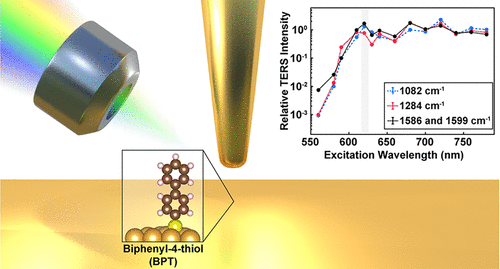当前位置:
X-MOL 学术
›
Nano Lett.
›
论文详情
Our official English website, www.x-mol.net, welcomes your feedback! (Note: you will need to create a separate account there.)
Tip-Enhanced Raman Excitation Spectroscopy (TERES): Direct Spectral Characterization of the Gap-Mode Plasmon.
Nano Letters ( IF 9.6 ) Pub Date : 2019-09-18 , DOI: 10.1021/acs.nanolett.9b02925 Muwen Yang 1 , Michael S Mattei 1 , Charles R Cherqui 1 , Xu Chen 1 , Richard P Van Duyne 1 , George C Schatz 1
Nano Letters ( IF 9.6 ) Pub Date : 2019-09-18 , DOI: 10.1021/acs.nanolett.9b02925 Muwen Yang 1 , Michael S Mattei 1 , Charles R Cherqui 1 , Xu Chen 1 , Richard P Van Duyne 1 , George C Schatz 1
Affiliation

|
The plasmonic properties of tip-substrate composite systems are of vital importance to near-field optical spectroscopy, in particular tip-enhanced Raman spectroscopy (TERS), which enables operando studies of nanoscale chemistry at a single molecule level. The nanocavities formed in the tip-substrate junction also offer a highly tunable platform for studying field-matter interactions at the nanoscale. While the coupled nanoparticle dimer model offers a correct qualitative description of gap-mode plasmon effects, it ignores the full spectrum of multipolar tip plasmon modes and their interaction with surface plasmon polariton (SPP) excitation in the substrate. Herein, we perform the first tip-enhanced Raman excitation spectroscopy (TERES) experiment and use the results, both in ambient and aqueous media, in combination with electrodynamics simulations, to explore the plasmonic response of a Au tip-Au substrate composite system. The gap-mode plasmon features a wide spectral window corresponding to a host of tip plasmon modes interacting with the plasmonic substrate. Simulations of the electric field confinement demonstrate that optimal spatial resolution is achieved when a hybrid plasmon mode that combines a multipolar tip plasmon and a substrate SPP is excited. Nevertheless, a wide spectral window over 1000 nm is available for exciting the tip plasmon with high spatial resolution, which enables the simultaneous resonant detection of different molecular species. This window is robust as a function of tip-substrate distance and tip radius of curvature, indicating that many choices of tips will work, but it is restricted to wavelengths longer than ∼600 nm for the Au tip-Au substrate combination. Other combinations, such as Ag tip-Ag substrate, can access wavelengths as low as 350 nm.
中文翻译:

尖端增强拉曼激发光谱(TERES):间隙模式等离激元的直接光谱表征。
尖端-基底复合系统的等离子特性对于近场光谱学,尤其是尖端增强拉曼光谱学(TERS)至关重要,该光谱学使得能够在单个分子水平上对纳米级化学进行操作研究。在尖端-基底接合处形成的纳米腔也提供了一个高度可调的平台,用于研究纳米级的场-物质相互作用。虽然耦合的纳米颗粒二聚体模型提供了间隙模式等离子体激元效应的正确定性描述,但它忽略了多极尖端等离子体激元模式的全部光谱以及它们与基质中表面等离子体激元(SPP)激发的相互作用。在此,我们进行了第一个尖端增强拉曼激发光谱(TERES)实验,并在环境和水性介质中均使用了该结果,结合电动力学模拟,以探索Au tip-Au基复合材料系统的等离子体响应。间隙模式等离激元具有宽的光谱窗口,该窗口对应于与等离激元基质相互作用的许多尖端等离激元模式。电场限制的仿真表明,当激发结合了多极尖端等离子体激元和衬底SPP的混合等离子体激元模式时,可获得最佳的空间分辨率。尽管如此,仍可使用1000纳米以上的宽光谱窗口来激发具有高空间分辨率的尖端等离激元,从而可以同时共振检测不同的分子种类。此窗口的健壮性取决于吸头与基材的距离和吸头的曲率半径,表明可以使用多种吸头选择,但是对于Au tip-Au基体组合,它的波长限制在约〜600 nm以上。其他组合(例如Ag tip-Ag衬底)可以访问低至350 nm的波长。
更新日期:2019-09-18
中文翻译:

尖端增强拉曼激发光谱(TERES):间隙模式等离激元的直接光谱表征。
尖端-基底复合系统的等离子特性对于近场光谱学,尤其是尖端增强拉曼光谱学(TERS)至关重要,该光谱学使得能够在单个分子水平上对纳米级化学进行操作研究。在尖端-基底接合处形成的纳米腔也提供了一个高度可调的平台,用于研究纳米级的场-物质相互作用。虽然耦合的纳米颗粒二聚体模型提供了间隙模式等离子体激元效应的正确定性描述,但它忽略了多极尖端等离子体激元模式的全部光谱以及它们与基质中表面等离子体激元(SPP)激发的相互作用。在此,我们进行了第一个尖端增强拉曼激发光谱(TERES)实验,并在环境和水性介质中均使用了该结果,结合电动力学模拟,以探索Au tip-Au基复合材料系统的等离子体响应。间隙模式等离激元具有宽的光谱窗口,该窗口对应于与等离激元基质相互作用的许多尖端等离激元模式。电场限制的仿真表明,当激发结合了多极尖端等离子体激元和衬底SPP的混合等离子体激元模式时,可获得最佳的空间分辨率。尽管如此,仍可使用1000纳米以上的宽光谱窗口来激发具有高空间分辨率的尖端等离激元,从而可以同时共振检测不同的分子种类。此窗口的健壮性取决于吸头与基材的距离和吸头的曲率半径,表明可以使用多种吸头选择,但是对于Au tip-Au基体组合,它的波长限制在约〜600 nm以上。其他组合(例如Ag tip-Ag衬底)可以访问低至350 nm的波长。











































 京公网安备 11010802027423号
京公网安备 11010802027423号